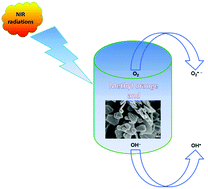当前位置:
X-MOL 学术
›
Mater. Chem. Front.
›
论文详情
Our official English website, www.x-mol.net, welcomes your feedback! (Note: you will need to create a separate account there.)
Photothermal effect: an important aspect for the enhancement of photocatalytic activity under illumination by NIR radiation†
Materials Chemistry Frontiers ( IF 7 ) Pub Date : 2017-10-10 00:00:00 , DOI: 10.1039/c7qm00337d Gururaj M. Neelgund 1, 2, 3 , Aderemi Oki 1, 2, 3
Materials Chemistry Frontiers ( IF 7 ) Pub Date : 2017-10-10 00:00:00 , DOI: 10.1039/c7qm00337d Gururaj M. Neelgund 1, 2, 3 , Aderemi Oki 1, 2, 3
Affiliation

|
A key auxiliary role of the photothermal effect (PTE) in the enhancement of photocatalytic activity under illumination by near-infrared (NIR) radiation has been experimentally revealed. It was found that the photoexcitation of electrons, required for the process of photocatalysis, does not occur in the presence of NIR radiation alone without the support of both UV and visible radiation. Herein, a binary heterogeneous nanophotocatalyst, GR–ZnO, was fabricated by a novel approach using a hydrothermal process, in which ZnO nanotrapezoids were deposited over the surfaces of graphene nanosheets. In the unique approach reported, the reduction of graphene oxide to graphene has been accomplished using water by an entirely alternative mechanism compared to traditional reduction processes which require hazardous reducing agents. The produced GR–ZnO photocatalyst exhibited excellent performance in the rapid degradation of a perilous dye, methyl orange voluntarily used in industry. It has been found that the PTE is mainly responsible for the rapid degradation of methyl orange, which occurs under NIR laser irradiation. Furthermore, it has been established that the PTE could not emerge with NIR radiation alone, without the support of both UV and visible radiation. Upon considering its importance, the PTE of the GR–ZnO nanocatalyst has been revealed and compared with that of its individual components, viz., graphene and ZnO. Moreover, the photothermal conversion efficiency of the GR–ZnO nanocatalyst was evaluated. Overall, the excellent catalytic activity found in the GR–ZnO nanocatalyst was accounted for by its decreased band gap, which arose because the hybridization of ZnO with graphene could efficiently prevent the recombination of photo-generated charge carriers, resulting in enhanced catalytic activity of GR-ZnO nanocatalyst was attributed to improved optical absorption and enhancement in the adsorption affinity to methyl orange molecules.
中文翻译:

光热效应:在NIR辐射照射下增强光催化活性的重要方面†
通过实验揭示了光热效应(PTE)在增强近红外(NIR)辐射照射下的光催化活性中的关键辅助作用。已经发现,在没有紫外线和可见光辐射的支持下,仅在存在近红外辐射的情况下,光催化过程所需的电子就不会发生电子的光激发。在此,采用水热法通过一种新颖的方法制备了二元均相纳米光催化剂GR-ZnO,其中ZnO纳米梯形沉积在石墨烯纳米片的表面上。在所报道的独特方法中,与传统的需要危险性还原剂的还原工艺相比,通过完全替代的机制,用水可以将氧化石墨烯还原为石墨烯。所生产的GR-ZnO光催化剂在快速降解工业上自愿使用的危险染料甲基橙方面表现出卓越的性能。已经发现,PTE主要负责甲基橙的快速降解,这是在近红外激光照射下发生的。此外,已经确定的是,没有紫外线和可见光的支持,单独使用NIR辐射就不会出现PTE。考虑到其重要性,已揭示了GR-ZnO纳米催化剂的PTE,并将其与各个组分的PTE进行了比较,已经确定,没有紫外线和可见光的支持,单独的NTE辐射就不会出现PTE。考虑到其重要性,已揭示了GR-ZnO纳米催化剂的PTE,并将其与各个组分的PTE进行了比较,已经确定,没有紫外线和可见光的支持,单独的NTE辐射就不会出现PTE。考虑到其重要性,已揭示了GR-ZnO纳米催化剂的PTE,并将其与各个组分的PTE进行了比较,即 ,石墨烯和ZnO。此外,还评估了GR-ZnO纳米催化剂的光热转化效率。总体而言,GR-ZnO纳米催化剂具有出色的催化活性,这是由于其带隙减小导致的,这是因为ZnO与石墨烯的杂化可以有效地阻止光生电荷载流子的重组,从而增强了GR的催化活性。 -ZnO纳米催化剂归因于改善的光吸收和对甲基橙分子的吸附亲和力的增强。
更新日期:2017-10-10
中文翻译:

光热效应:在NIR辐射照射下增强光催化活性的重要方面†
通过实验揭示了光热效应(PTE)在增强近红外(NIR)辐射照射下的光催化活性中的关键辅助作用。已经发现,在没有紫外线和可见光辐射的支持下,仅在存在近红外辐射的情况下,光催化过程所需的电子就不会发生电子的光激发。在此,采用水热法通过一种新颖的方法制备了二元均相纳米光催化剂GR-ZnO,其中ZnO纳米梯形沉积在石墨烯纳米片的表面上。在所报道的独特方法中,与传统的需要危险性还原剂的还原工艺相比,通过完全替代的机制,用水可以将氧化石墨烯还原为石墨烯。所生产的GR-ZnO光催化剂在快速降解工业上自愿使用的危险染料甲基橙方面表现出卓越的性能。已经发现,PTE主要负责甲基橙的快速降解,这是在近红外激光照射下发生的。此外,已经确定的是,没有紫外线和可见光的支持,单独使用NIR辐射就不会出现PTE。考虑到其重要性,已揭示了GR-ZnO纳米催化剂的PTE,并将其与各个组分的PTE进行了比较,已经确定,没有紫外线和可见光的支持,单独的NTE辐射就不会出现PTE。考虑到其重要性,已揭示了GR-ZnO纳米催化剂的PTE,并将其与各个组分的PTE进行了比较,已经确定,没有紫外线和可见光的支持,单独的NTE辐射就不会出现PTE。考虑到其重要性,已揭示了GR-ZnO纳米催化剂的PTE,并将其与各个组分的PTE进行了比较,即 ,石墨烯和ZnO。此外,还评估了GR-ZnO纳米催化剂的光热转化效率。总体而言,GR-ZnO纳米催化剂具有出色的催化活性,这是由于其带隙减小导致的,这是因为ZnO与石墨烯的杂化可以有效地阻止光生电荷载流子的重组,从而增强了GR的催化活性。 -ZnO纳米催化剂归因于改善的光吸收和对甲基橙分子的吸附亲和力的增强。



























 京公网安备 11010802027423号
京公网安备 11010802027423号